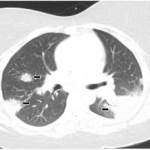I thought to myself that sounds entirely reasonable. Residual muscle and joint pain is not unusual after a viral illness. It should burn out.
I Meet the Patient
Then I opened the door. Mrs. N looked up from her Sudoku puzzle. She reached into her purse and pulled out several pages of hand-written notes. “Thank you for seeing me. I’m a mess and don’t know where to start.”
“Okay. Well, let’s begin with the last time you were well,” I suggested.
She ran a finger down the left side of the first page. “March 14. Larry, my husband, kept me up all night with a nasty cough. The next day, I was coughing, too.”
I glanced down at her chart. Of course, Larry N, a retired surgeon, was her husband. Now I remember. That’s why Dr. Hanson called me earlier this week, hoping I could fit in Mrs. N. Hmm, that rules out lunch. I settled in. Emergent spousal consults generally go in two directions, and both take a long time. Either there is hypervigilance regarding persistent but innocent symptoms, or the spouse has a rare, life-altering disorder. Mrs. N, I suspected, had a heavy dose of the former.
“So we were both sick for about 10 days. By March 24,” she moved her finger down to the next entry, “Larry was fine. He bounced back, but I took a turn for the worse. Stiff? I was so stiff I could hardly move. That’s when we decided I should see Dr. Hanson.”
“And I have his notes here,” I interjected. “The chest X-ray was okay, and basic lab, the CBC, chem profile and throat culture were all normal.” Filling in the blanks, I’ve learned, helps consolidate the story and also lets the patient know that I’ve reviewed their chart.
“Well, not really. Here.” She pointed to the chemistry profile where the BUN (blood urea nitrogen) was one point above the normal range.
I blinked. “The BUN, yes the BUN is borderline, but with the other kidney test, here,” I pointed to the creatinine on the next line, “very much in the normal range, the BUN doesn’t have any significance.”
She stared silently at me, then said, “That’s what Larry said. But it’s not normal.” I was thinking: precise, literal, uses language carefully. “So anyway, Dr. Hanson thought we both probably had a virus, but since my cough was hanging on, he prescribed azithromycin.”


